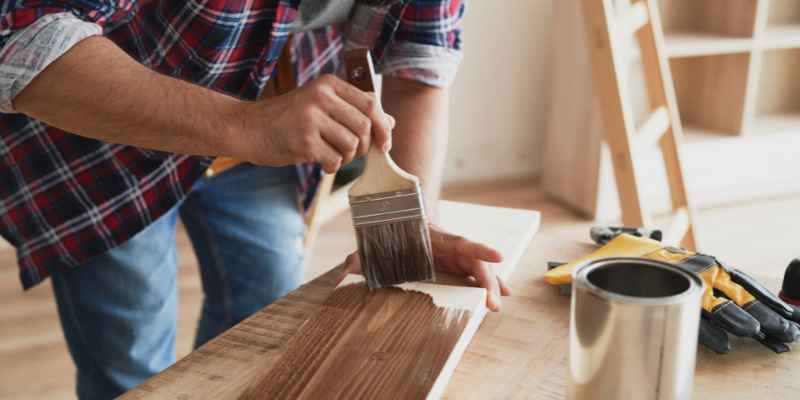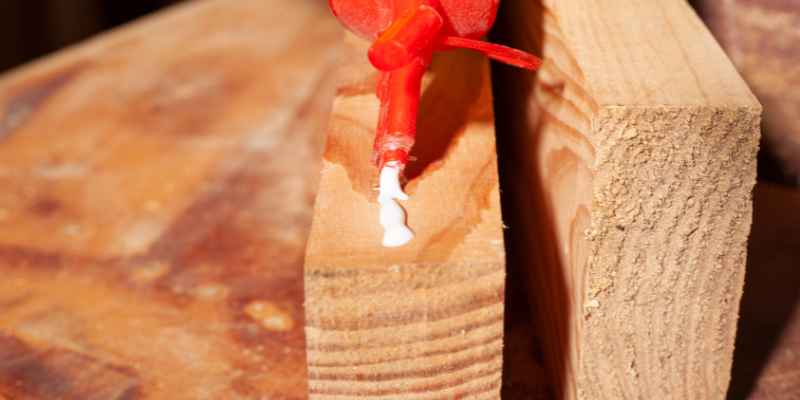Yes, you can glue stained wood, but wood glue works best on bare wood surfaces. Staining wood blocks the pores, hindering glue penetration and potentially weakening the bond.
However, using certain types of glue, such as Elmer’s wood glue that is stainable and waterproof, can help achieve a strong bond even on stained wood. When working with stained wood, it’s crucial to consider the type of glue you use and its compatibility with the stained surface to ensure a secure and lasting bond.
While staining before gluing can be appropriate in certain situations, it’s essential to choose the right type of glue to achieve optimal results.
Understanding Gluing Stained Wood
Gluing stained wood presents a unique set of challenges due to the presence of a barrier created by the stain, which can hinder the adhesive bond. When attempting to glue stained wood, it is crucial to understand the factors that affect glue adhesion on stained surfaces.
Several factors influence the adhesion of glue on stained wood, including the type of stain used, the nature of the wood, and the type of adhesive being applied. The interaction between these elements can determine the success or failure of the bonding process.
When staining wood before gluing, it’s essential to consider using stainable and waterproof glues, such as Elmer’s wood glue. The properties of this specific glue allow it to maintain premium stainability and bond strength even on stained surfaces. Additionally, it is non-toxic and easy to clean with water, making it suitable for both indoor and outdoor projects.
However, it’s important to note that wood glue only works effectively on bare wood, as the presence of stain can seal the surface, preventing the wood fibers from bonding with each other. This highlights the importance of the sequence when working with stained wood – whether to stain then glue or vice versa – in order to achieve a strong and durable bond.
Furthermore, the type of dye used on wood can also impact its compatibility with glue. When the dye is suspended in water or alcohol, the absence of an oil layer allows the wood to be glued together just like untreated wood, providing opportunities for successful bonding without compromising the dyed finish.
Moreover, surface preparation plays a crucial role in gluing stained wood. Prior to applying adhesive, it is essential to sand the surfaces to be bonded to remove any barriers created by the stain, allowing the glue to penetrate the wood and create a secure bond.
Ultimately, while some woodworking glues may work for gluing together painted or stained surfaces, it is important to remember that the overall bond strength will depend on the adhesion between the paint or stain and the wood.
Best Techniques For Gluing Stained Wood
When it comes to gluing stained wood, it’s essential to follow the best techniques to ensure a strong and durable bond. This article will discuss the key considerations when gluing stained wood, including selecting the right glue and preparing the wood for gluing.
Selecting The Right Glue For Stained Wood
Choosing the appropriate glue is crucial for bonding stained wood effectively. While many wood glues are available, not all are suitable for stained wood. One of the best options for gluing stained wood is Elmer’s wood glue.
This high-quality glue is both stainable and waterproof, offering superior bond strength and premium stainability. It’s perfect for both indoor and outdoor projects, as it is resistant to mold, heat, and mildew. Additionally, this non-toxic glue is easy to clean with water, making it a convenient choice for woodworkers of all levels.
Preparing Stained Wood For Gluing
Before gluing stained wood, it’s essential to prepare the surfaces properly to ensure a successful bond. Here are some steps to follow:
- 1. Sanding: Begin by sanding the stained wood surfaces that will be glued. Sanding helps create a rough texture, allowing the glue to adhere better to the wood fibers. Use a fine-grit sandpaper and sand in the direction of the wood grain for the best results.
- 2. Cleaning: After sanding, make sure to remove any dust or debris from the surfaces. Clean the stained wood using a soft brush or a lint-free cloth to ensure a clean and smooth bonding surface.
- 3. Masking: If you plan to stain the wood after gluing, it’s important to mask off the areas that will be glued. This will prevent the glue from interfering with the staining process.
- 4. Applying the Glue: Once the wood is properly sanded and cleaned, apply the selected glue to one of the surfaces using a brush, roller, or spreader. Be sure to apply an even layer of glue to ensure a strong bond.
- 5. Clamping: After applying the glue, join the surfaces together and clamp them firmly. This will help distribute the glue evenly and create a tight bond. Leave the clamped wood in place for the recommended drying time specified by the glue manufacturer.
By following these techniques for gluing stained wood and using the appropriate glue, you can achieve strong and long-lasting bonds for your woodworking projects. Remember to always carefully read and follow the instructions provided by the glue manufacturer for the best results.
Can You Glue Stained Wood?
Gluing stained wood may seem like a tricky task, but with the right techniques, it can be successfully achieved. Let’s delve into the impact of stains on wood glue and address common concerns to understand how to work with stained wood effectively.
Impact Of Stains On Wood Glue
Stains on wood can pose challenges when it comes to gluing, as they can block the pores of the wood, making it difficult for the glue to penetrate and create a strong bond. It is crucial to prepare the surfaces properly to ensure optimal adhesion.
Addressing Common Concerns
- Best Glue for Stained Wood: Elmer’s wood glue is known for its stainable and waterproof properties, making it a suitable choice for bonding stained wood while maintaining a strong and durable hold.
- Wood Glue Compatibility: Wood glue works effectively on bare wood surfaces as it bonds with the wood fibers. Staining the wood beforehand can hinder the bonding process, so it’s important to consider the sequence of staining and gluing.
- Gluing Dyed Wood: When dealing with dyed wood, the dye composition can impact the effectiveness of wood glue. However, if the dye is water or alcohol-based and evaporates completely, gluing dyed wood is still possible.
- Surface Preparation: Properly sanding the wood surfaces before applying glue is essential to create a clean and adhesive-friendly surface. This step ensures optimal bonding between the wood pieces.
Understanding Wood Stains And Glue Adhesion
When working with stained wood, it is crucial to consider the impact on glue adhesion. Staining wood blocks the pores, preventing proper glue penetration. To maintain a strong bond, it’s recommended to apply glue on bare wood before the staining process.
How Wood Stains Affect Glue Absorption
When it comes to gluing stained wood, understanding the effects of wood stains on glue absorption is crucial. The nature of wood stains can affect the adhesive properties of glue and determine how well the two materials bond together. Wood stains, whether oil-based or water-based, can create a barrier on the surface of the wood, making it more difficult for glue to penetrate and create a strong bond.
Stains that contain pigments tend to create a film on the surface of the wood, blocking the pores and reducing the absorption of glue. On the other hand, clear stains or stains with a minimal pigment content may not create as much of a barrier, allowing the glue to penetrate and bond more effectively.
Types Of Wood Stains And Their Impact On Glue
There are various types of wood stains available in the market, and each type can have a different impact on glue adhesion. Here are a few common types:
- Oil-Based Stains: These stains are made by mixing colorants with a drying oil, such as linseed oil. Oil-based stains generally create a thicker film on the surface of the wood, reducing glue absorption. It is important to keep in mind that oil-based stains may take longer to dry, and it is recommended to wait until the stain is completely dry before applying glue.
- Water-Based Stains: Water-based stains are made by mixing colorants with a water-based binder. They are typically thinner in consistency compared to oil-based stains and can allow better glue absorption. However, some water-based stains may contain additives that can affect the adhesive properties of glue, so it is important to test the compatibility before applying glue.
- Gel Stains: Gel stains have a thicker consistency compared to traditional stains. They are easier to control and can be layered for a more intense color. However, the thicker consistency of gel stains can create a thicker barrier on the wood surface, reducing glue absorption. It is recommended to sand the stained wood surface before applying glue to improve adhesion.
It is important to consider the type of wood stain used and its impact on glue absorption when gluing stained wood. Testing the compatibility between the chosen wood stain and glue on a small inconspicuous area is always a good practice before moving forward with larger projects. Sanding the stained wood surface or using specialized stainable glues can also help improve adhesive performance.
Ensuring Strong Adhesion On Stained Wood
When working with stained wood, it’s important to ensure a strong adhesion. Using Elmer’s wood glue, known for its premium stainability and waterproof properties, is a great choice for both indoor and outdoor projects. However, it’s crucial to apply the glue on bare wood for optimal bonding.
Additionally, be sure to sand the wood before gluing to ensure a smooth surface for better adhesion.
Proper Surface Preparation For Gluing Stained Wood
To ensure optimal adhesion when gluing stained wood, proper surface preparation is vital. Thoroughly clean the surfaces to be glued and remove any existing finish or residue that may hinder adhesion. Sanding the stained wood lightly can help create a rough surface for the adhesive to grip onto.
Techniques To Enhance Glue Adhesion On Stained Wood
Enhancing glue adhesion on stained wood requires specific techniques. Consider using a wood glue that is compatible with stains, such as Elmer’s wood glue. This stainable formula offers excellent bond strength and is resistant to mold and mildew.
- Ensure the wood surface is clean and free of any contaminants.
- Apply the glue evenly and allow it to set according to the manufacturer’s instructions.
- If gluing dyed wood, ensure that the dye used is water or alcohol-based to prevent adhesion issues.
Remember, wood glue works best on bare wood surfaces as it bonds with the wood fibers directly. If the wood has been stained or painted, the glue may not adhere properly. Prepping the surface correctly before gluing is key to achieving a strong adhesion on stained wood.
Gluing Techniques For Specific Stained Wood Projects

When it comes to working with stained wood, proper gluing techniques are crucial to ensuring a strong and long-lasting bond. Whether you are working on an outdoor or indoor project, understanding the specific gluing techniques for stained wood is essential to achieving the desired results.
Gluing stained outdoor wood projects requires a glue that is not only strong and durable but also resistant to the elements. The Elmer’s wood glue is a great option for outdoor projects as it is both stainable and waterproof. This premium glue offers excellent bond strength and can withstand mold, heat, and mildew. Additionally, it is non-toxic and easy to clean with water, making it a safe and convenient choice for outdoor applications.
When working on stained indoor wood projects, using the right glue is essential to ensure a strong and reliable bond. Elmer’s wood glue is a suitable option for indoor applications as well. Its stainability and bond strength make it a reliable choice for achieving seamless joints in your stained wood projects. Moreover, its non-toxic formulation and easy water clean-up make it a user-friendly glue for indoor use.
| Advantages | Description |
|---|---|
| Stainable | Allows the wood to maintain its stained appearance without compromising the bond quality. |
| Waterproof | Withstands exposure to moisture and prevents the glue from deteriorating over time. |
| Easy to Clean | Can be easily cleaned with water, saving time and effort during the project. |
| Non-Toxic | Does not contain any harmful chemicals, ensuring the safety of both the user and the environment. |
- Ensure the wood surfaces are clean and free from dust or debris before applying the wood glue.
- Apply an even layer of glue to both surfaces that need to be bonded.
- Press the surfaces together firmly and hold them in place for the recommended drying time.
- Avoid applying excessive pressure, as it can cause the stained wood to warp or split.
By following these gluing techniques for specific stained wood projects, you can achieve strong and durable bonds that will withstand the test of time. Whether you are working on an outdoor or indoor project, using a reliable glue like Elmer’s wood glue will ensure the success of your stained wood projects.
Common Mistakes When Gluing Stained Wood
When gluing stained wood, it’s important to avoid applying the adhesive over the stained surface, as it can prevent the glue from penetrating and bonding properly. Ensure that the wood surfaces are sanded before applying the glue to allow for a strong bond.
Using a stainable and waterproof wood glue, like Elmer’s wood glue, is crucial for successful adhesion on stained wood projects.
Failing To Adapt Gluing Techniques For Stained Wood
When it comes to gluing stained wood, one of the most common mistakes is failing to adapt your gluing techniques to accommodate the stain. Stained wood typically has a protective layer, such as paint or varnish, which can prevent the glue from properly bonding with the wood fibers. This can result in weak or ineffective glue joints that may eventually fail.
To avoid this mistake, it is important to take a few extra steps when gluing stained wood. First, make sure to sand the stained surface before applying any glue. Sanding will help remove the protective layer and expose the raw wood fibers, allowing the glue to penetrate and create a stronger bond.
Additionally, consider using a adhesive specifically designed for use on stained wood, such as a stainable wood glue. These glues are formulated to bond effectively with stained surfaces, ensuring a strong and durable connection.
Using Incompatible Glue On Stained Wood
Another common mistake when gluing stained wood is using an incompatible glue. Certain types of glue may not adhere well to stained surfaces, leading to weak bond strength and potential failure of the joint.
It is important to choose the right type of glue for your project. When working with stained wood, opt for a glue that is specifically formulated for use on stained surfaces. These glues are designed to provide a strong bond and work effectively with the stain, ensuring a durable connection.
Incompatible glues, such as standard wood glues, may not adhere properly to the stain or the underlying wood, resulting in a weak bond. This can lead to joint failure over time and compromise the structural integrity of your project.
By using a compatible glue, you can ensure a secure and long-lasting bond between the stained wood pieces, avoiding any potential issues down the line.

Expert Tips And Recommendations
If you’re wondering about gluing stained wood, it’s essential to follow expert insights and recommendations to ensure a strong and lasting bond. Let’s delve into some valuable tips and advice from woodworking experts in the field.
Expert Insights On Gluing Stained Wood
- Wood glue works best on bare wood surfaces.
- Ensure the wood is clean and free from any existing finishes or stains before applying glue.
- Consider using pre-stain conditioners to prepare the wood for staining after gluing.
Recommended Glues And Techniques For Stained Wood
When it comes to choosing the right glue for stained wood, Elmer’s wood glue is highly recommended. It offers premium stainability and bond strength, making it ideal for both indoor and outdoor projects.
Remember to sand the wood before gluing to ensure a smooth and clean surface for optimal adhesion. Additionally, be cautious when gluing together painted or stained surfaces, as the bond strength may vary based on the compatibility of the paint or stain with the glue.
Frequently Asked Questions Of Can You Glue Stained Wood
What Is The Best Glue For Stained Wood?
Elmer’s wood glue is the best for stained wood, offering stainability, waterproofing, and strong bonding. It’s ideal for indoor and outdoor projects, mold-resistant, non-toxic, and easy to clean.
Will Wood Glue Work After Staining?
Wood glue will not work effectively after staining. Staining wood seals it, preventing the wood fibers from bonding with each other. If you want to glue wood that has been stained, you can pre-stain and then mask off the area to be glued.
Use a stainable and waterproof glue like Elmer’s wood glue for best results.
Does Wood Glue Work On Dyed Wood?
Wood glue can work on dyed wood because the dye does not interfere with the bonding process. The glue forms a bond between the wood fibers and can be used on dyed wood just like untreated wood.
Does Wood Need To Be Sanded Before Gluing?
Sand bare wood before gluing to ensure proper bond between wood fibers. Stained wood seals, preventing bond formation.
Conclusion
When it comes to gluing stained wood, using Elmer’s wood glue is a top choice. It offers stainability, bond strength, and resistance to mold and heat. Remember to work with bare wood for optimal adhesion. Consider masking off stained areas for successful bonding.
Choose the right adhesive for a lasting hold.


